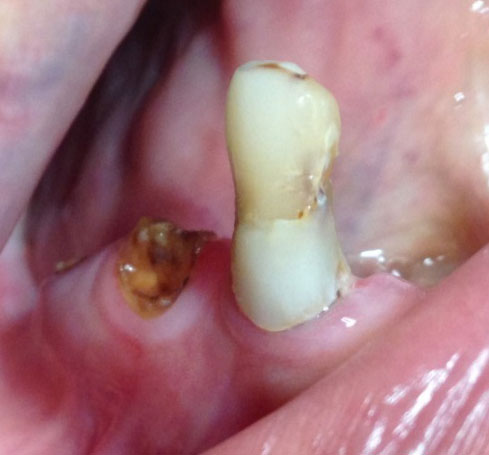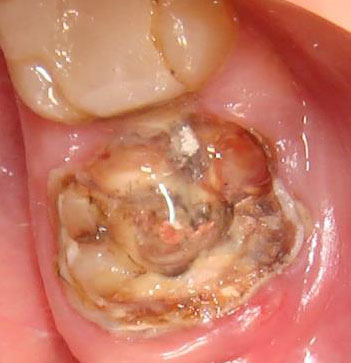Introduction
The goal of dental treatment is to save the natural tooth for a lifetime. However, there are instances in that a tooth cannot be saved and, therefore, render it “non-restorable.” These teeth cannot be retained in the mouth for any significant, predictable period of time.
Clinical features
In some cases, tooth may be so heavily broken down; either through tooth decay, fracture, or trauma, it may not be possible to provide a long term restorable option with the available tooth structure. In these instances it may be best to consider options of tooth extractions and options available for replacement.

Fig. 1 The unrestorable tooth- lower second premolar

Fig. 2 The unrestorable tooth-lower first molar
Underlying causes
Here are a few reasons why a tooth may be considered non-restorable:
- Extensive decay or destruction of the natural tooth structure. This scenario prevents a dentist from adequately restoring the tooth, leaving it susceptible to further decay, pain, and possible infection.
- Advanced periodontal issues. If periodontal issues are not controlled, this predisposes the teeth to recession, bone loss, and eventual loss of the tooth.
- Tooth resorption is a dental process that occurs when the cells that surround the tooth begin to eat away at it, which is typically due to some form of trauma.
- A crown-to-root ratio that is less than one to one is not ideal. In other words, the remaining tooth that is encapsulated in bone should be at least the same amount that is outside the bone. Torqueing forces that are exerted on the tooth are an unstable environment for any tooth, especially one that is already compromised.
- Avulsed or “knocked out,” tooth and is not put back into the socket within one hour (depending on stage of root development), the overall prognosis for retaining that tooth is poor, and the tooth will eventually be non-retainable.
- Vertical root fractures especially if it communicates with the oral cavity, has a hopeless prognosis and is considered non-retainable.
Restoring a Severely Compromised Tooth
Objectives
There are many important factors involved in deciding whether or not the tooth can be restorable. Prosthodontic prognosis, Periodontal prognosis, Endodontic prognosis and some relevant general factors are such an examples. The virtue objective of restoring is to:
- Promote tooth survival.
- Restore pain-free function.
- Protect the remaining tooth structure against further carious and non-carious tissue loss.
- Provide occlusal stability and proximal contacts with adjacent teeth.
- Provide optimal aesthetics.
- Promote health in the marginal periodontal tissues.
- Promote periapical health.
Restoration of Compromised Teeth
Optimal restorative management of the compromised tooth can only be achieved through a systematic and thorough assessment of the tooth, within the context of the dentition, the supporting structures and the patient as a whole. Of course, every patient is different and this must be appreciated when treatment planning decisions are made. There are some patients who may be willing to go to almost any length in the hope of holding on to a tooth, even if the prognosis is acknowledged to be guarded. Alternatively, some patients may be reluctant to embark on any complex work, or wish only to invest in options which they consider to be predictable.
Why need for extraction
Tooth which cannot be restored endodontically or used as support in dentures/ prosthetics wearing may need for extraction.
They can cause pathosis that will lead to yet more infection, inflammation not only to itself but also the surrounding supporting tissues and bone structures underlying it leading to severe gum disease, bone shrinkage and even sometimes tooth fracture.
Replacing missing teeth
There are a few options for replacing missing teeth; however, each situation is unique and a lot of the pros and cons of each replacement option would depend on the individual, oral hygiene factors, the condition of adjacent teeth, comfort, goals, aesthetics, and numerous other factors. In addition, the status of the neighbouring teeth may be a very important consideration in deciding the best option for the patient.
Implant : A titanium fixture is placed into the bone where there is missing tooth and allowed to heal. After the implant has integrated, a crown is placed onto the substructure that looks like a standalone tooth.
Bridge : The adjacent teeth to the missing tooth are crowned and splinted together to support and replace the missing tooth the middle.
Denture : Can be made to replace one missing tooth or many, they can come as flexible resin, or a metal cobalt chrome backing.
Leaving the space : In some cases a viable option is to leave the space where the tooth has been removed.
References
- What Is A Non-Restorable Tooth?. August 2, 2016; Dr. Susan Wood/ google search
- 9 Reasons for Tooth Extraction – Dr. M. Jasim. Source: dentistsnearby.com/google search
| Last Reviewed | : | 28 August 2020 |
| Writer | : | Dr. Balkis bt. Ghazali |
| Accreditor | : | Dr. Rohani bt. Mahmood |
| Reviewer | : | Dr. Roshima bt. Mohd Sharif |







